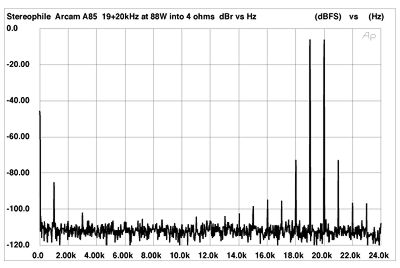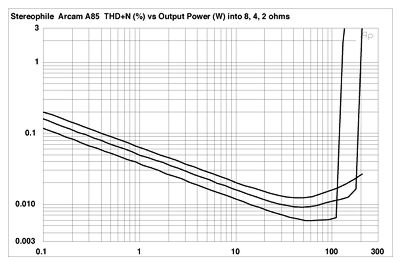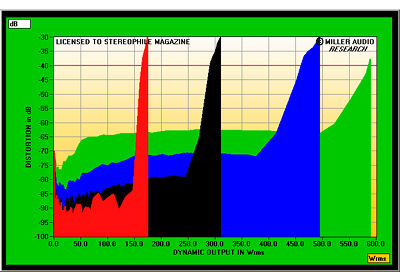| Columns Retired Columns & Blogs |
Arcam DiVA A85 integrated amplifier Measurements part 2
The innocuous nature of low-order harmonics present in an amplifier's output depends on there not being high levels of intermodulation distortion. This was true of the Arcam; fig.6 shows that, even close to the clipping point with the punishing 1:1 mix of 19kHz and 20kHz tones, the 1kHz difference product remained below -80dB (0.01%). However, the higher-order products at 18kHz and 21kHz did rise in level as the load impedance dropped, which suggests that those admittedly rare speakers that drop to 2 ohms and below at high frequencies are perhaps best avoided.

Fig.6 Arcam DiVA A85, HF intermodulation spectrum, DC-24kHz, 19+20kHz at 80W into 4 ohms (linear frequency scale).
After the one-hour preconditioning period at one-third full power with both channels driven into 8 ohms, the DiVA A85's chassis was warm, but not so hot that I couldn't keep my hand on it. However, when I inadvertently continued running the amplifier on its side, meaning that the convective air cooling of the internal heatsink fins became much less efficient, the A85 quickly shut down, its front-panel display giving a "thermal overload" warning. Although the DiVA protects itself in a graceful manner, as any amplifier should, its cooling vents should not be obstructed.
Fig.7 shows how the A85's distortion rises with output power under continuous drive with both channels driven. The nominal clipping point (1% THD+N) is quite a bit higher than specified, at 120W into 8 ohms (20.8dBW) and 200W into 4 ohms (23dBW). However, into 2 ohms with one channel driven (the top trace in this graph), the A85 turned itself off at 200W output.

Fig.7 Arcam DiVA A85, distortion (%) vs continuous output power into (from bottom to top at 100W): 8 ohms, 4 ohms, 2 ohms.
Finally, I used the Miller Amplifier Profile to examine how the A85 behaves with a low-duty-cycle 1kHz toneburst signal more like music than a continuous sinewave. The results with one channel driven are shown in fig.8. Even more power is available at the 1% THD clipping point with this signal: 164.5W into 8 ohms (red trace, 22.2dBW), 290W into 4 ohms (black, 21.6dBW), 461W into 2 ohms (blue, 20.6dBW), and 586W into 1 ohm (green, 18.65dBW). The latter is equivalent to an RMS output current of 24.2A, maintained for the 10ms duration of the pulse. However, the fact that the DiVA again turned itself off at this maximum level into the low impedance, coupled with the higher levels of distortion, suggests that speakers that drop much below 4 ohms are probably best avoided with the relatively modest-priced Arcam.—John Atkinson

Fig.8 Arcam DiVA A85, distortion (%) vs 1kHz burst output power into 8 ohms (red trace), 4 ohms (black), 2 ohms (blue), 1 ohm (green).
- Log in or register to post comments




































